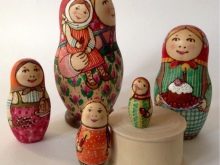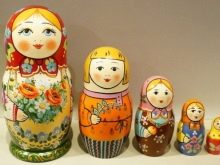All about Zagorsk nesting dolls
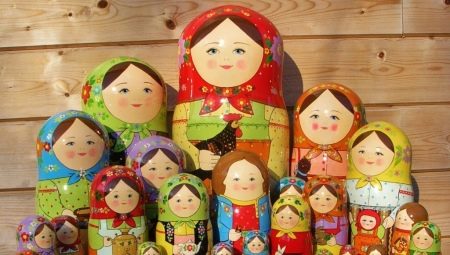
Matryoshka is a bright original doll that embodies the best traditions of making Russian craft toys. It has become a kind of symbol of Russia and seems to be very "ancient", although in fact the fishery is just over 100 years old. Matryoshka dolls are made in Polkhov-Maidan, Vyatka, Semyonov, and they all differ in their style and distinctive features. But the most famous is Sergiev Posad, she is Zagorskaya. We will tell you about its features and history in this article.

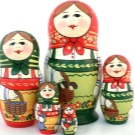
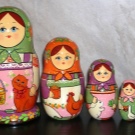
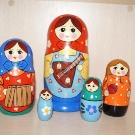
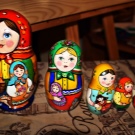
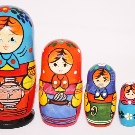
Peculiarities
Matryoshka is a detachable doll made of several figures nested inside one another. Most often, there are from 3 to 12 of them in one set, but there are more.
The most characteristic plot for the Zagorsk style is a bright, elegant, rosy-cheeked girl-doll, holding bouquets of flowers or pets, and dishes. But the subject matter is much broader, and depending on it, two sub-styles are distinguished - "peasant" and "boyar". Peasant depicts peasant girls in kerchiefs and sundresses with knots, sickles, bouquets of flowers, shepherdesses. Boyarsky - heroes, boyars, princes, epic, fairy-tale and historical heroes.
Not all dolls in the set are the same characters. For example, one of the first nesting dolls ("Malyutinskaya") contained figures of girls and boys, which differed from each other. Sets were created, representing the heroes of the fairy tale. For example, "Turnip": a large matryoshka depicted a grandfather, the next - a grandmother, and so on. There were nesting dolls depicting newlyweds with guests. And even the generals of the war of 1812 (Kutuzov, Napoleon) with their headquarters.
But the most popular image is members of a large peasant family.

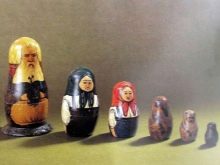
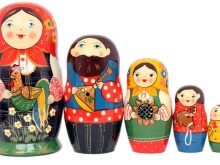
Sergiev Posad nesting dolls are bright, colorful, each of them is unique in its own way, the style does not impose strict frameworks, but at the same time its features are very recognizable. They are as follows:
- contrasting saturated colors;
- shiny lacquered surface;
- detailed drawing of small details of clothing and objects;
- the outline of each part is outlined;
- the costume is decorated with ornaments and decorative elements with plant motifs and a pattern of dots and circles (motley);
- gilding is richly applied;
- there is no unpainted space on the surface of the toy.
The doll is always bright and cheerful, with a blush on her cheeks and a light kind smile. She embodies a holiday, joy for children and adults. Matryoshka is never sad or sad.
Her joy is contagious, communication with nesting dolls is an excellent remedy for a bad mood. Perhaps that is why this amazing Russian doll is so loved all over the world.
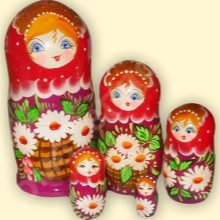
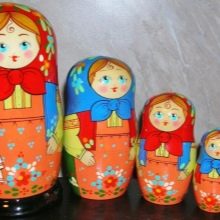
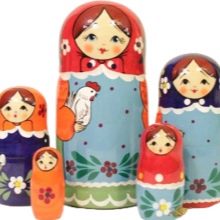
The history of development
The matryoshka became popular in Russia and gained worldwide fame thanks to the figurine carved by the talented toy turner Vasily Zvezdochkin and painted by the famous artist Sergei Malyutin.
The "Malyutinskaya" nesting doll consisted of 8 figurines painted in a stylized folk style. They portrayed children of different ages. The largest doll is a girl with a black rooster in her hands, a traditional peasant symbol of prosperity and prosperity. The smallest is a swaddled baby.
This nesting doll was presented in 1900 at the international exhibition in Paris, where she won a bronze medal and immediately became popular with visitors from all over the world, turned into the main Russian souvenir.
The fashion for everything Russian, which arose after the Diaghilev seasons, especially "fueled" the demand. Russian toy makers began to receive orders from all over the world.
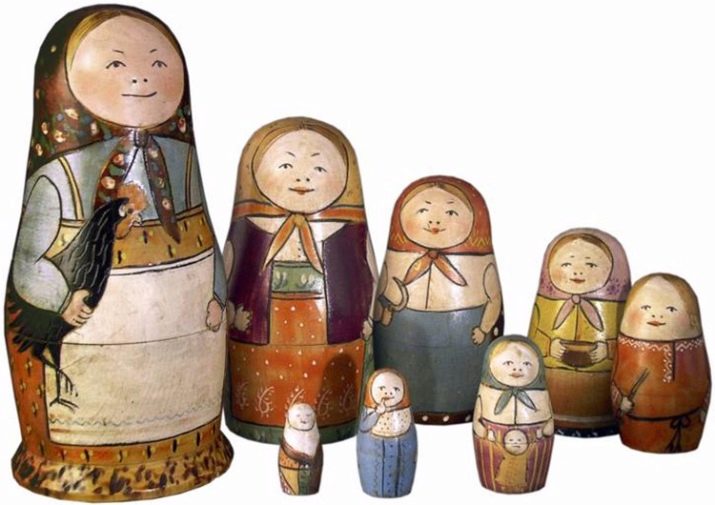
From a small workshop in Moscow, where Zvezdochkin worked, the production was moved to the "capital of folk toys" - Sergiev Posad. Local talented artisans quickly picked up the idea.
By 1910, many matryoshka workshops and private craftsmen were already working in Posad, which eventually united into an artel. Craftsmen created bright, original figures, in the painting of which the unique handwriting of each author was read. There are ruddy girls, children, heroes, gypsies with bears, boyars and fairy-tale heroes. But gradually a special style began to take shape - in many respects, because the painting was somewhat simplified, stylized, as is often the case with mass, albeit manual, production. It has become almost impossible to distinguish between dolls painted by different artists, but the nesting doll has become truly "folk".
After the revolution of 1917, the "Sergievskaya handicraft industrial artel" continued to work, despite all the changes in the country. In 1930 it was renamed “Zagorskaya”, following the renaming of the city to Zagorsk. The style of painting was also called Zagorsk.
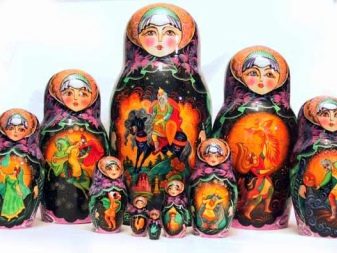
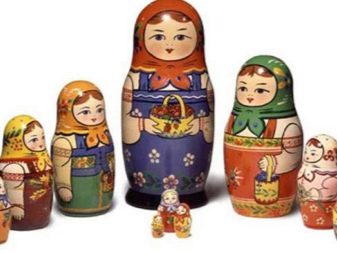
In 1960, on the basis of a toy artel, the Zagorsk Toy Factory No. 1 was organized, where various toys were produced, including nesting dolls. Each matryoshka was painted by hand, but the style was even more unified in accordance with the requirements of "in-line" production. All nesting dolls from the set, as a rule, were painted in the same way and differ only in size. These are girls with bouquets of flowers or baskets in their hands. The matryoshka became associated with this image.
In 1992, the factory was privatized. Nowadays it is called ZAO "Art products and toys" and pleases children and adults with its products.
But today matryoshka is not only a factory one, the main attraction of Sergiev Posad (its historical name was returned to it in 1992) - a revived folk craft. There are many talented private craftsmen working in the city who paint figurines in their own unique manner. They create toys both in the pre-revolutionary "peasant" style, and in a more modern one.
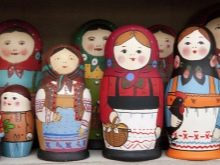
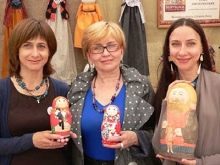
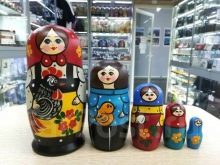
Elements of painting
Zagorsk nesting dolls are painted in a certain way.
- On the head of female figurines there is always a headdress - usually it is a scarf tied in a knot, from under it you can see two strands of hair.
- Front apron. If a plot picture is drawn, then it is on the apron.
- The oval of the face and hands are painted over with a "flesh" color.
- The drawing of the face is quite detailed, but at the same time, it is quite minimalistic, stylized, vaguely reminiscent of the iconographic manner.
As a rule, the face and apron are first signed, and then the scarf and sundress. At the end of the 19th century, gouache was used for painting; in our time, tempera, watercolors, oil and aniline paints are also used. Painting is done without preliminary drawing using 4-5 colors: yellow, blue, green, red, orange.
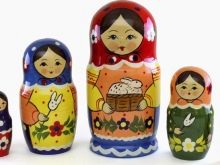
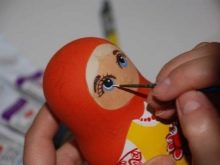
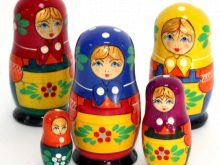
Typical elements of the painting.
- Ornament on clothes and the edges of the scarf. This is a simple geometric pattern or floral motifs - leaves, flowers, berries. Such a pattern is easily obtained if you apply a brush with paint, leaving a trace-petal or leaf.
- Clothes and a scarf are often generously showered with speckled dots and circles, which are drawn simply with a poke-touch.
- The outlines of all details are drawn in black with a thin solid line or burned out.
Drawn nesting dolls are primed before painting, then they are usually varnished. Survivors may not sign or be varnished, only sometimes they are decorated with "gold".

